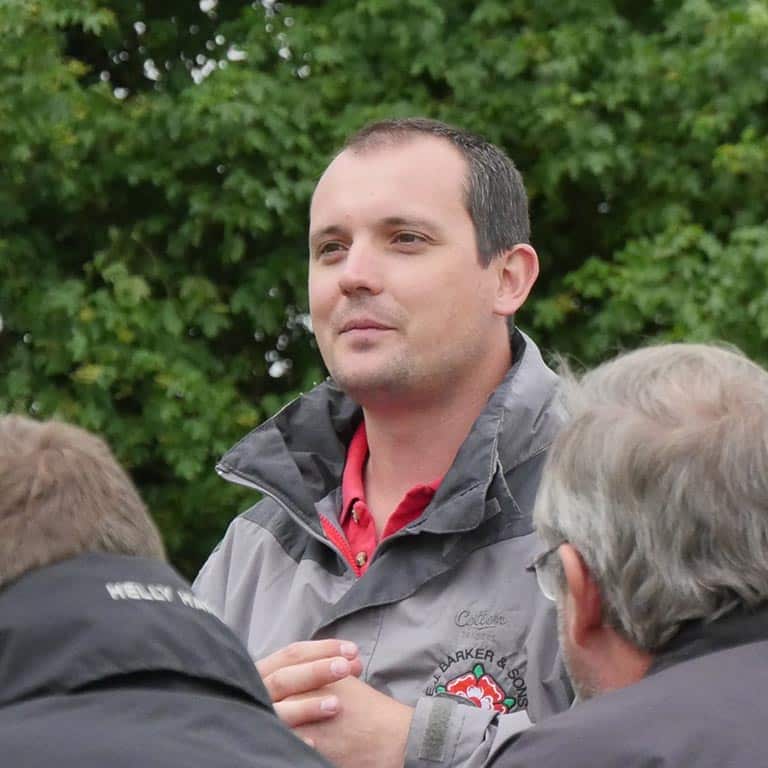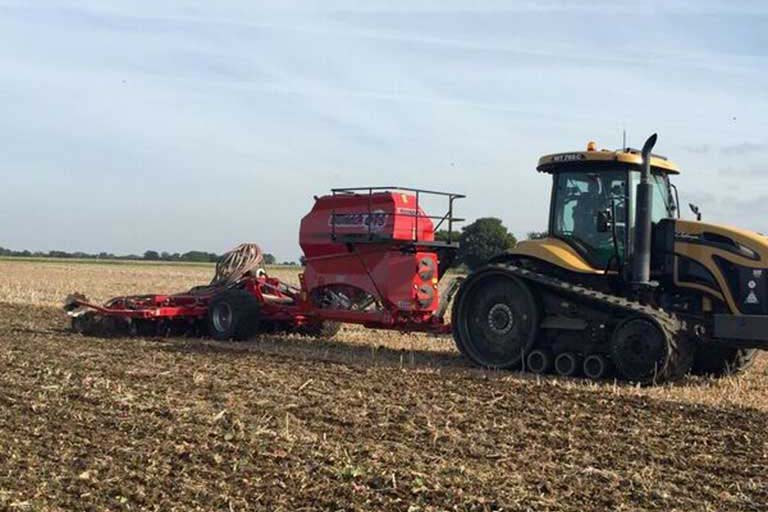Project Description
- Client: Brian Barker
- Category: Machines

Suffolk farmer aims to cut soil establishment costs and boost overall soil health over time
Moving less soil, and using cover crops in a rotation, should improve yield and long term soil management in the future, according to EJ Barker and Sons, who’ve already cut their diesel and wearing part usage during crop establishment, and are now hoping to see soil structure benefits from their new strategy.
Surprisingly the 580ha (1,450ac) enterprise based at Westhorpe, near Stowmarket, made the decision to invest in two drills – a decision that wasn’t taken lightly, but one where the reasoning stacked up nicely, according to Brian Barker, who farms alongside his cousin Patrick.
“Of course we’re keen on the advantages of moving as little ground as possible to improve soil condition and cutting costs, but on some land, in some years, and for some crops, we may have to move a little more – through strip tillage – and in other circumstances we may be able to move less by direct drilling, particularly on lighter land and when spring drilling into winter cover crops.”
Adopting a twin drill approach means that they can adapt their crop establishment methods to suit the wide range of soils from high-calcium/low magnesium shrinking clay to silty clay loam, says Brian, who’s introduced both spring and cover crops to precede the wheat.
The decision to remove oilseed rape from the rotation was also made due to cost of production and pest pressure, with the focus instead going to building the benefits of their grass seed leys with spring crops following a cover crop.
Rotation now comprises of two wheats followed by a cover crop, spring beans or spring linseed, two further wheats, another cover crop, and then spring wheat or spring barley undersown with herbage grass seed, followed by another two-year grass ley.
“We didn’t feel that moving completely and immediately over to direct drilling was a viable option, being unlikely to suit all of our soils, our cropping patterns, and every year’s weather,” says Brian.
“Previously we had established half of our cropping, which is all combinable, using non-inversion tillage equipment which would be followed by one or two passes with a press, and drilled with a 6m disc cultivator drill. For the other half, second wheat, we would plough, press and drill.”
Having looked at a number of different strip-till drills, the Barkers felt the Sumo DTS offered better value for money, better contour-following and accurate depth control.
“Some of the others have a rigid frame design, but the Sumo DTS coulter units are individual, and under constant pressure, and so follow ground contours much more accurately, ensuring seed depth is consistently accurate,” believes Brian.
“We also felt some of the other drills moved too much soil, with tines that are too large. As we wanted to reduce the horsepower and the fuel needed to establish our crops, as well as minimise soil movement, the narrow DTS tines were appealing. Calibration and coulter checking is also much easier with the DTS. In short, it looked like a machine designed by someone who had actually been drilling.”
The DD direct drill was favoured for many of the same reasons, with narrow openers – in this case single discs – offering minimal disturbance, and individually hydraulically-adjustable coulter downforce providing consistent seed depth and ground penetration in hard conditions.
“With the cultivation passes and the associated time and fuel they accounted for removed from the establishment process, our sums showed we could justify a twin fleet of a direct disc machine and a strip-till tine coulter drill, using each according to the field soil type, moisture, the preceding crop and the crop being drilled.”
A 5m DTS and a 4m DD were purchased through local dealer Thurlow Nunn Standen, with the former subsequently coupled to the farm’s 320hp AGCO Challenger 765C and the DD working behind either the 260hp Fendt 826 or the 160hp Fendt 516. While the new crop establishment system is still in its early stages, some advantages quickly became apparent.
“We saved two 10,000-litre deliveries of diesel during the 2015 summer and early autumn by not using our old cultivation methods,” says Brian.
“It’s still early to calculate drilling costs, but so far the versatility of the system is working well, with the DTS proving well-suited to establishing autumn crops. We’re also planning to use it for spring beans. For the moment, the plan is for the DD to be primarily a spring drill, for wheat, barley and linseed going directly into sprayed-off cover crops, although we’ve also used it to drill wheat into old grass leys and into some lightly cultivated stale seed beds.
“In lowering our establishment costs, we hope that input costs will follow in time as our soil finds a balance.
“We’re aware that some costs may rise as we meet different challenges such as slugs, but also expect others to fall as the new long-term system begins to work in favour of our soil and crops.”
At present, the existing tractor fleet, comprises of an AGCO Challenger 765C and three Fendts – an 826, an 820 and a 516 – but the idea of selling one and rebalancing the farm’s horsepower as the soil structures improve and their traffic-carrying capacity rises is under consideration.
“The idea of running two drills may surprise some people, and I’ll admit we’re still on a learning curve with our new system. As time goes on, we may find we have less need to strip-till some ground, and it could become more suited to direct drilling, but we have no problem with retaining the plough as an emergency re-set button.
“It will only be used if absolutely necessary, though. At the moment we still can’t be sure how much and how quickly the structure and natural drainage will change. We do know, though, that we’ve got the two drills to give us full versatility according to the field/season/crop circumstances at less than the price of one smaller machine of at least two other makes, and have cut the time needed to get crops in the ground.”
Gallery



